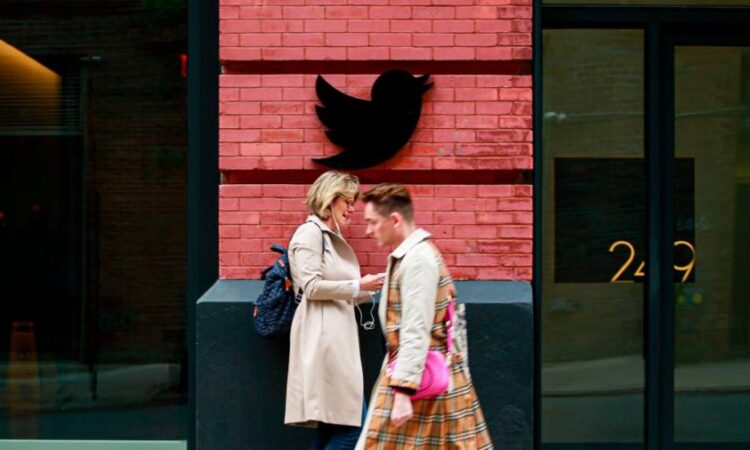
Goldman Sachs was hit by a surge in commercial real estate loan delinquencies in the first quarter, fuelled in part by Elon Musk’s refusal to pay Twitter’s rent.
The value of loans to commercial real estate borrowers (CRE) behind on repayments climbed 612 per cent in the first quarter to $840mn, according to reports filed by Goldman’s licensed banking entity with the US Federal Deposit Insurance Commission.
That was much higher than the rise in delinquent CRE loans reported by the entire US banking industry, which were up 30 per cent over the same period to just over $12bn, according to Bankingregdata.com, which collates the FDIC reports.
The jump in delinquencies at Goldman’s deposit-taking business comes at a time when rival banks are warning over growing losses on commercial real estate loans, most of which are tied to office buildings and were made before the pandemic ushered in a work-from-home culture.
Goldman has much less exposure to commercial real estate lending than its larger rivals. At the end of the first quarter, it had $8.4bn of outstanding loans backed by commercial property, according to the FDIC report. Wells Fargo had $91bn and Bank of America had $60bn.
However, the surging delinquencies are another sign of the frustrations the bank has faced as it tries to diversify its business away from its traditional focus on deals and trading.
Goldman was among a group of banks including Citigroup and Deutsche Bank that lent $1.7bn to Columbia Property, a real estate investment trust, against seven office buildings in San Francisco and New York, including two that house large offices for Twitter.
Twitter stopped paying its rent in November and Elon Musk, the billionaire owner of the social media network, has told employees he does not intend to restart payments or cover past dues, according to lawsuits. Columbia Property, which is suing Twitter over the missed payments, defaulted on the loan in February. Columbia Property declined to comment. Twitter, which has adopted a policy of not replying to the press, could not be reached for comment.
Given Goldman’s relatively small exposure to the sector, the bad loans will not have a material impact on its earnings. “Lending doesn’t matter that much for Goldman,” says Christopher Kotowski, a banking analyst at Oppenheimer. Commercial real estate lending accounts for less than 20 per cent of the bank’s overall loan book, according to Goldman’s own calculations.
Still, more than 10 per cent of its CRE loans held in its banking subsidiary, which accounts for 90 per cent of its overall loans, are in some form of delinquency, according to Bankingregdata.com, whereas the average delinquency at its peers is less than 1 per cent.
In SEC filings and discussions with investors, Goldman defines its CRE lending more broadly and includes loans made to investment firms that buy and sell real estate debt as well as loans used to pool CRE loans into investment securities.
On that yardstick, delinquencies are lower, but still higher than peers. “If you look at the entirety of our commercial real estate lending activities, our delinquency rate is below 2 per cent,” said Goldman.
The FDIC, though, puts these loans, which tend to have much lower default rates, into a different category.
Goldman, which became a regulated bank in the wake of the financial crisis, has spent the past decade putting more resources into lending. The firm now has nearly $180bn of bank loans outstanding, up from $3bn a decade ago.
In 2020, Goldman said corporate lending was one of the firm’s priorities. “We are embracing the bank model,” said then chief financial officer Stephen Scherr, during a presentation to investors. “We believe this will be an important source of future upside for the firm.”
The bank has benefited from higher interest rates, with profits at its lending entity rising to $3.7bn in the first quarter — an all-time high and a 20 per cent jump from the same period of last year.
Nonetheless, the larger loan book is also a source of potential losses given Goldman’s willingness to lend to riskier corporate borrowers compared with its rivals. Just over 65 per cent of its commercial loans are to “junk” borrowers without an investment grade credit rating, compared with 28 per cent and 17 per cent for JPMorgan Chase and Citi, respectively.
Goldman’s total volume of delinquent loans, according to FDIC data, jumped to $3.2bn at the end of the first quarter, or about 2 per cent of its loans outstanding, up from $2.4bn a year ago.
Most of those are tied to credit cards and other consumer loans, which make up about 65 per cent of its loan loss provisions, per Bankregdata.com.
Goldman earlier this year signalled its intention to pull back from lending to consumers by selling off $1bn of loans tied to its Marcus consumer bank.
David Fanger, who follows Goldman for bond rating firm Moody’s Investors Service, said: “Even though their risk appetite may be larger than other firms, they are generally more proactive in risk management.”





